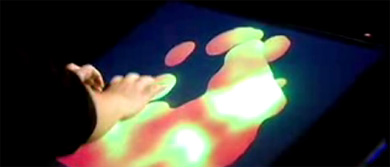
We have seen the future of tech interfaces, and it’s interactive. This cool list includes T.E.D.D.Y, the I/O Brush, and PlayAnywhere. Don’t know what they are? Find out after the jump.
5. Virtual Painter Interface
“Touch Me Tender” is an early prototype interface that eventually aims to replace photo editing programs such as Adobe Photoshop and MS Paint. It allows users to paint with their fingers directly on the screen.
The way they visualized the interface is great. They actually took the traditional way of painting, with a glass of water, jars of paint and different kinds of brushes, and brought that to the screen
[Source]
4. I/O Brush
At first glance, it looks like your standard brush, but upon closer inspection you’ll find integrated LEDs, touch sensors, and a camera. The I/O Brush basically “lifts up and captures photons”, allowing artists to draw with “special ink” picked up from their immediate environment.
I/O Brush looks like a regular physical paintbrush but has a small video camera with lights and touch sensors embedded inside. Outside of the drawing canvas, the brush can pick up color, texture, and movement of a brushed surface.
[Source]
3. T.E.D.D.Y. – 2D to 3D Interface
T.E.D.D.Y. is an innovative “Java-Applet Drawing Program that takes the 2D images you draw and renders them in 3D.”
The alogrithm adds shading according to the strokes and connections between the lines. This is truly a cool program for anyone and everyone
2. PlayAnywhere
PlayAnywhere is basically a “prototype interactive display surface that transforms any ordinary surface” into a gaming interface.
Computer vision technology is used to sense when the user touches the surface and to reason about other objects placed on the surface, such as game pieces
[Source]
1. Jeff Han’s Touch Interface
So you’ve seen Jeff Han’s multi-input touch screen, now “he demonstrates—for the first time publicly—his intuitive, ‘interface-free,’ touch-driven computer screen, which can be manipulated intuitively with the fingertips, and responds to varying levels of pressure.”
The drafting table style implementation shown here measures 36″x27″, is rear-projected, and has a sensing resolution of better than 0.1″ at 50Hz. Stroke event information is sent to applications using the lightweight OSC protocol over UDP
